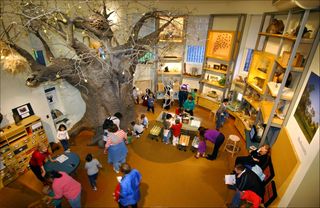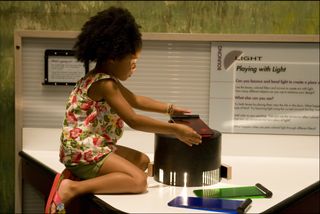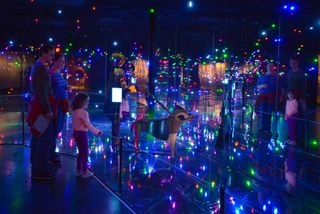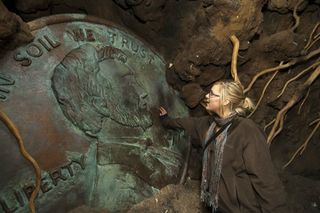7 Science Museums to Visit This Summer
Investigate and explore

During the hottest summer days, science museums can provide a cool break from the steamy temperatures outdoors — as an afternoon "getaway" in your hometown, a weekend day trip or part of an extended vacation.
Science centers, natural history museums and interactive spaces offer exhibits and programs that appeal to a range of ages. They provide opportunities for the entire family to explore exciting mysteries about the world around them, in a variety of displays that let you investigate and do activities together.
From immersive theater projections that hurtle you through space and time, to reconstructions of creatures that lived millions of years ago, here are some destinations for curious minds seeking a closer look at the many marvels that populate the planet under your feet, the sky above your head, the cosmos beyond the solar system and the inside of your body.
Museum of Science (Boston)

The Museum of Science features more than 700 permanent exhibits with numerous opportunities for hands-on, experiential learning about natural history, nanotechnology, engineering and energy.
If visitors crave an electrifying indoor lightning display, they can visit the museum's "Theater of Electricity" and encounter the world's largest air-insulated Van de Graaff generator, which hurls crackling bolts capable of sparking anyone's curiosity about storms and safety.
Temporary exhibits offered this summer include "Space: An Out-of-Gravity Experience," introducing visitors to the "sights, sounds, and smells" experienced by an astronaut living and working in microgravity on the International Space Station; and "Crocs: Ancient Predators in a Modern World," exploring the evolution and biology of crocodilians, the water-dwelling, fearsome reptile group that includes alligators and crocodiles.
American Museum of Natural History (New York City)

Dinosaur halls? Check. Suspended blue whale in an immense, dimly lit space populated with scenes of ocean life? Check. A round-trip ticket to the end of the universe and back in the planetarium theater? Check. New York's iconic American Museum of Natural History has a lot to offer — spectacular fossils, rare minerals, anthropology collections representing cultures worldwide, and hall after hall of dioramas that act as windows into the lives of animals around the world.
Fans of the popular "Night at the Museum" movies can search for some of the famous exhibits that come to life in the film, such as the T. rex, located in the Hall of Saurischian Dinosaurs; the Easter Island head that served as the model for "Dum-Dum," in the Margaret Mead Hall of Pacific Peoples; and Neanderthals in the Hall of Human Origins. Visitors can even pose for a selfie with a seated statue of Theodore Roosevelt in the Roosevelt Rotunda.
This summer, the interactive exhibit "Our Senses" challenges visitors to take a closer look at all the ways in which their sight, smell, hearing, taste and touch enable them to experience and interpret the world around them. An exhibit on the human microbiome, "Inside You," explains how trillions of microbes that live on and inside our bodies coexist with us to keep us healthy. And the space show "Dark Universe" offers a breathtaking tour of the cosmos, narrated by astrophysicist Neil deGrasse Tyson, to explore one of the universe's biggest mysteries — dark matter.
National Museum of Natural History (Washington, D.C.)

At the National Museum of Natural History, 124 million objects await you, including the Hope Diamond — the largest blue diamond in the world — a living coral reef and a collection of mummies. Permanent exhibitions cover earth sciences, dinosaur fossils, human diversity, and animals and their ecosystems, to name a few.
Inside FossiLab — a real fossil laboratory in one of the museum's public spaces — visitors can watch paleontologists as they unpack, clean, conserve and document new fossil arrivals and samples from the museum's extensive collection.
Like insects? The museum's Insect Zoo features live demonstrations, tarantula feedings, and opportunities to observe a number of insects and other arthropods, some of which are available for visitors to hold and touch.
Among the museum's temporary exhibits are, "Outbreak: Epidemics in a Connected World," showing visitors the causes of disease outbreaks in the modern world, as well as the methods for tracking and containing epidemics; and "Narwhal: Revealing an Arctic Legend," showcasing the biology and habits of this iconic ocean mammal, exploring its connection to Inuit culture, and diving deep into the icy Arctic habitat where narwhals live.
Fernbank Museum of Natural History (Atlanta)

With every step you take at the Fernbank Museum of Natural History, you're walking on fossils. The museum's floors, made up of 40,000 limestone tiles, hold the fossil remains of animals that lived more than 150 million years ago, in a shallow reef.
Fernbank is home to fossils representing some of the world's largest dinosaurs, and hosts Atlanta's biggest IMAX screen. Their collections and displays offer an introduction to Georgia's natural history as well as an overview of cultures, traditions and artifacts from around the world.
Curious about the science of the food on your table? The exhibit, "Food: Our Global Kitchen," open through August 19, offers summer visitors a chance to learn about the origins and history of different crops, spices and produce; the cultural traditions that shape our meals and how we share them with others; and the challenges of feeding more than 7 billion people in a warming world.
The Field Museum (Chicago)

Does the prospect of visiting the largest T. rex ever found appeal to you? How about exploring an Egyptian tomb, or witnessing DNA research? If that sounds exciting, a visit to The Field Museum is well worth your time, with exhibits that inspire an appreciation for nature and human culture.
Visitors can even experience a bug-size view of the world in the "Underground Adventure" exhibit, an immersive environment that offers an entirely new perspective on tiny creatures and how they live underground.
This summer, prepare to discover the dinosaurs that lived in what is now the coldest and most forbidding landscape on the planet — Antarctica. But 255 million years ago, Antarctica was covered in lush forests, and diverse populations of dinosaurs roamed the verdant landscape. "Antarctic Dinosaurs" introduces dozens of extinct species, including four dinosaur species that aren’t found anywhere else on Earth, and showcases the techniques and technologies used by the paleontologists who excavate and study these ancient animals.
La Brea Tar Pits and Museum (Los Angeles)

It's not every day that you can visit a museum that's also a dig site, where down-and-dirty paleontology is taking place on its very grounds. Mammal fossils on display at the La Brea Tar Pits and Museum emerged from — where else? — tar pits, which are just a short walk from the main museum building. Some of the tar pits are in the process of being excavated, with paleontologists working to extract the remains of ancient animals and plants buried there.
Inside the museum, more than 1 million ice-age fossils from the tar pits are on display, including mammoths, saber-toothed cats and dire wolves. At the center is the Fossil Lab, a large room surrounded by glass where visitors can watch preparators as they clean and assemble fossils, from the miniscule to the massive, and the museum offers behind-the-scenes tours that provide an up-close view of how researchers prepare and study these objects from the distant past.
As you stroll around outside, you may encounter small patches of ancient tar near the larger pits that were former excavation sites. Tours of the park's dig sites — past and present — offer a unique perspective of Los Angeles many thousands of years ago.
California Academy of Sciences (San Francisco)

The California Academy of Sciences promises "a daily dose of wonder," and is the only location on the planet where you can find a natural history museum, a planetarium and an aquarium under the same roof.
As if that weren't enough, there's also an educational play space for toddlers, and a Project Lab — a window into the research that takes place every day, involving 60 scientists and hundreds of researchers.
There are plenty of opportunities for hands-on experiences, such as touching sea creatures in the Discovery Tidepool, and handling pelts, shells and other specimens in the Naturalist Center. Stop by the Osher Rainforest exhibit — the biggest rainforest exhibit in the world — and drink in the rainbow of hues found in a variety of plants and animals that are native to the Amazonian rainforest, all housed in a temperature-controlled glass dome measuring 90 feet (27 meters) in diameter.
Planning an outdoor adventure this summer? Just make sure you steer clear of these frightening fungi, beastly bacteria and deadly diseases.
This story was updated on July 2, 2018.
Sign up for the Live Science daily newsletter now
Get the world’s most fascinating discoveries delivered straight to your inbox.

Mindy Weisberger is an editor at Scholastic and a former Live Science channel editor and senior writer. She has reported on general science, covering climate change, paleontology, biology, and space. Mindy studied film at Columbia University; prior to Live Science she produced, wrote and directed media for the American Museum of Natural History in New York City. Her videos about dinosaurs, astrophysics, biodiversity and evolution appear in museums and science centers worldwide, earning awards such as the CINE Golden Eagle and the Communicator Award of Excellence. Her writing has also appeared in Scientific American, The Washington Post and How It Works Magazine.
